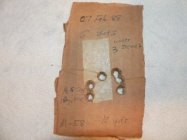Multitoes, think of reloading and the powder charge like the tachometer in a car. Running at the RPM red line is hard on the engine and reduces its engine life. (and the same applies to a firearm)
Below is the maximum charge of 296 in a 357 revolver from Hodgdon's website, the chamber pressure is 34,735 psi (Red line on the tach) and only 65.76% of the powder is burnt because of the four inch barrel.
Below is a reduced practice load for the 357, the chamber pressure is 18,636 psi. Also please notice 100% of the powder is burnt at a little over three inches of barrel length.
Loading near or at maximum pressure (red line on the tachometer) is hard on a firearm and your brass. With lower chamber pressures you are cruising at 4,000 rpm and getting great gas mileage from your car/firearm.
And yes there is a difference between a medium frame and large frame revolvers and the pounding they will take.
My son doesn't reload and sold me his S&W model 29-5 five inch .44 Magnum because the factory loaded ammunition he was shooting was hot and giving him a pounding.
He came home for Christmas and shot the same revolver that was reloaded and turned into a pussycat. The Speer reloading manual has loads for short barreled revolvers, and these loads can be reduced even further for very good practice loads you can shoot all day long.
The charts above are from Quickload, the green dotted line is 95% burnt and the purple line is 100% burnt. Please note the top .357 chart doesn't even have a 95% burnt line, meaning you need to figure barrel length into the reloading equation to reduce muzzle blast and the added "rocket thrust".














